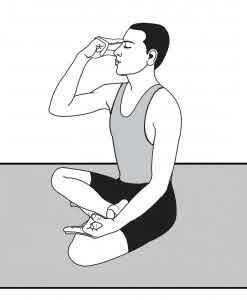Anulom Colon and it's benefits.
Anulom-Vilom Pranayama {Steps And Benefits}

Anulom Vilom Pranayama is one of several Pranayama or breathing exercise used in the practice of Hatha yoga. At first you have to understand the meaning of Anuloma and Viloma .In this the first word Anu roughly translates as with and word Loma means hair implying “with the grain” or “natural”. And meaning of Viloma is “against the grain.” Anuloma is opposite to Viloma. It is very helpful in respiratory related diseases like Asthama. Anulom Vilom Pranayama is the best way to balancing the Tri dosas in our body. Our body get ill when Tri dosas are not in balancing position. Vaat, Pitta, Kaffa are know as Tri dosas, Tri means “three” and the meaning of dosas is impurities. All these are present in body of every people. If one of them is imbalance than we suffer from different diseases. All of three are the cause of all diseases. So it’s important to balance these tri dosas. If you really want to balance these Tri dosas than do Anulom vilom pranayam regularly. It is the simplest and best way for this.
Steps of Anulom Vilom Pranayama
Anulom Vilom Pranayama is very easy to do, first of all close your eyes and sit in Padmasana and rest your hands on your knees.
Close the right nostril with the right thumb.Inhale slowly through the left nostril, inhale the oxygen as much as you can, this will fill your lungs with air.

Remove your thumb from your right nostril, as you remove your thumb from right nostril just exhale.
When you exhale use your middle finger to close your left nostril then inhale with our right nostril and remove thumb from right nostril then exhale. Repeat this process for 5 minutes.
Be focused and concentrate in your breathing.
Benefits of Anulom Vilom Pranayama
Helps to cure mental problems like Depression, Anxiety, Tension etc.
Most beneficial for breathing related problems like (Bronchitis, Asthama) etc.
Improve the working of lungs.

Anulom Vilom Pranayama is the ideal pranayama for healthy heart. Anulom Vilom Pranayama is also known as Nadi shodhana pranayam (alternate nostril breathing). It is next level of Anulom Vilom. In Anulom Vilom Pranayama we inhale and exhale, but in Nadi shodhana pranayam we hold (kumbhaka or retention) our breath for a second or minute than exhale.
Steps of Nadi Shodhana Pranayama (next level of Anulom Vilom Pranayama)
Sit on padmasana (lotus pose) close your eyes. Your spine should be erect.
Than inhale through your left nostril, while inhale close your right nostril with your right thumb.
When you feel your lungs is full of air than close left nostril by ring and middle finger, and your right nostril should also close.

Hold the breath for a minute or as much as you can, than exhale through right nostril. After that inhale through right nostril and close the left nostril by your left thumb, as you inhale completely just close your right nostril with thumb and left nostril by ring and middle finger.
Hold your breath (retention) for a minute than exhale by your left nostril.
Once cycle is complete, repeat the cycle for 3 or five minutes.
Benefits of Nadi shodhana pranayama
The benefits of nadi shodhan pranayama is Same as the benefits of Anulom Vilom Pranayama.
Don’t get confuse in Anulom vilom and Nadi shodhana pranayam. Both are same but in Nadi shodhana we hold our breath that’s it. Another name of Anulom Vilom Pranayama is Nadi shodhana. First of all you have to practice Anulom Vilom Pranayama when you are perfect than you’ll go for next level of Anulom Vilom Pranayama (Nadi shodhana).
Same as Anulom Vilom Pranayama first level, difference is when we inhale from our left nostril than hold for second or minute than exhale through your right nostril.
Important Points: –
Try Do pranayama in the morning with empty stomach. If you haven’t enough time in morning than do it in evening but keep a several hour gap between your meals and pranayama.
When you are trying to do Nadi shodhana note that inhalation, retention and exhalation are all in equal duration which is called Sama vrtti and this is for beginners.
People who are more advanced may try Visama vrtti or uneven breath, by using the ratio such as 1:4:2. (1 beat inhale, 4 beat retention, and a 2 beat exhale.
Thank you for the valuable and informative post.
Thank you for the valuable and informative post.
Thank you for the valuable and informative post.